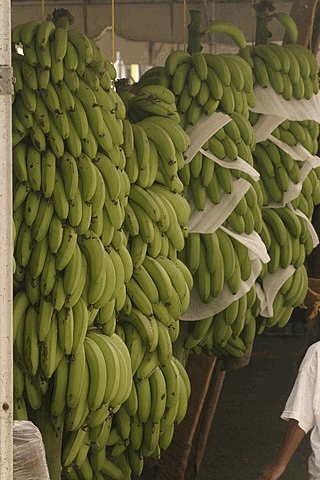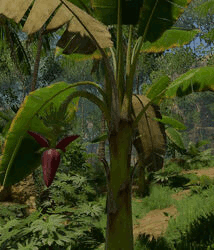Plantain
Scientific Name: Musa paradisiaca
Climate: Temperate and hot.
Plant Description: The banana tree is a huge perennial herb and not, in fact, a tree. It grows from a rhizome, producing a false trunk with spirally growing leaves. It can grow up to ten meters tall. The fruit, which grows in bunches, is typically green and is bigger than the common Cavendish variety of banana. Unlike the common banana, it does not develop a yellow colour.
Cultivation: The easiest way to cultivate plantains is to separate an offshoot or suckling from the base of the main stem, taking care not to damage the rhizome or roots. This is planted in a hole in loamy, well-drained soil in direct sunlight. The hole should be big enough for the rhizome and at least 30 cm from any other seedlings and two meters from other plantains. The hole is filled with a mixture of soil and compost and then covered with mulch. During the first four months it requires water every three days.
They begin to produce fruit which can be harvested about a year after planting. They can last for up to 15 years.
 Uses: While the banana is eaten fresh as a sweet fruit, the plantain is starchier and is generally boiled, fried, or roasted. It can also be dried and ground into a flour. It is an excellent source of fiber, potassium and also contains vitamins A, B and C. The plantain has antimicrobial, analgesic and anti-inflammatory properties.
Uses: While the banana is eaten fresh as a sweet fruit, the plantain is starchier and is generally boiled, fried, or roasted. It can also be dried and ground into a flour. It is an excellent source of fiber, potassium and also contains vitamins A, B and C. The plantain has antimicrobial, analgesic and anti-inflammatory properties.
As a source of potassium, the fruit helps regulate blood pressure and helps heart rhythm. The fiber aids digestion and it also functions as a laxative. As a rich source of vitamin C, it aids in growing and repairing tissues in the body. Combined with vitamin A, it helps to boost the immune system. Both are also important antioxidants. There are indications that the plantain is effective in the treatment of colds and respiratory problems.
Plagues and Diseases: The banana aphid and the banana weevil are two insects that commonly affect the plantain. The aphids affect the leaves and can result in curled leaf. If detected early, they can be controlled by treatment with soapy water. If the leaves are severely infested, they should be removed and destroyed. The weevil can result in destruction of the roots, stunted growth, poor harvest, or plant death. To prevent this, it is important to use healthy organic material for planting and ensure that sucklings used for cultivation are washed and free of infection.
Although Panama disease mainly affects the Cavendish variety of banana, it also represents a threat to the plantain. There are indications that the cultivation of cassava together with the banana tree may protect it from the fungus that causes Panama disease. The plantain can also be affected by a range of fungi. These can be avoided through good soil management, cleaning debris from the base of the plant, and removal and destruction of severely affected plants.
References:
https://www.britannica.com/plant/plantain
https://homeguides.sfgate.com/cultivate-plantain-26215.html
https://www.healthbenefitstimes.com/plantains/
https://plantvillage.psu.edu/topics/plantain/infos/diseases_and_pests_description_uses_propagation
https://theconversation.com/the-quest-to-save-the-banana-from-extinction-112256
En español: Plátano verde

